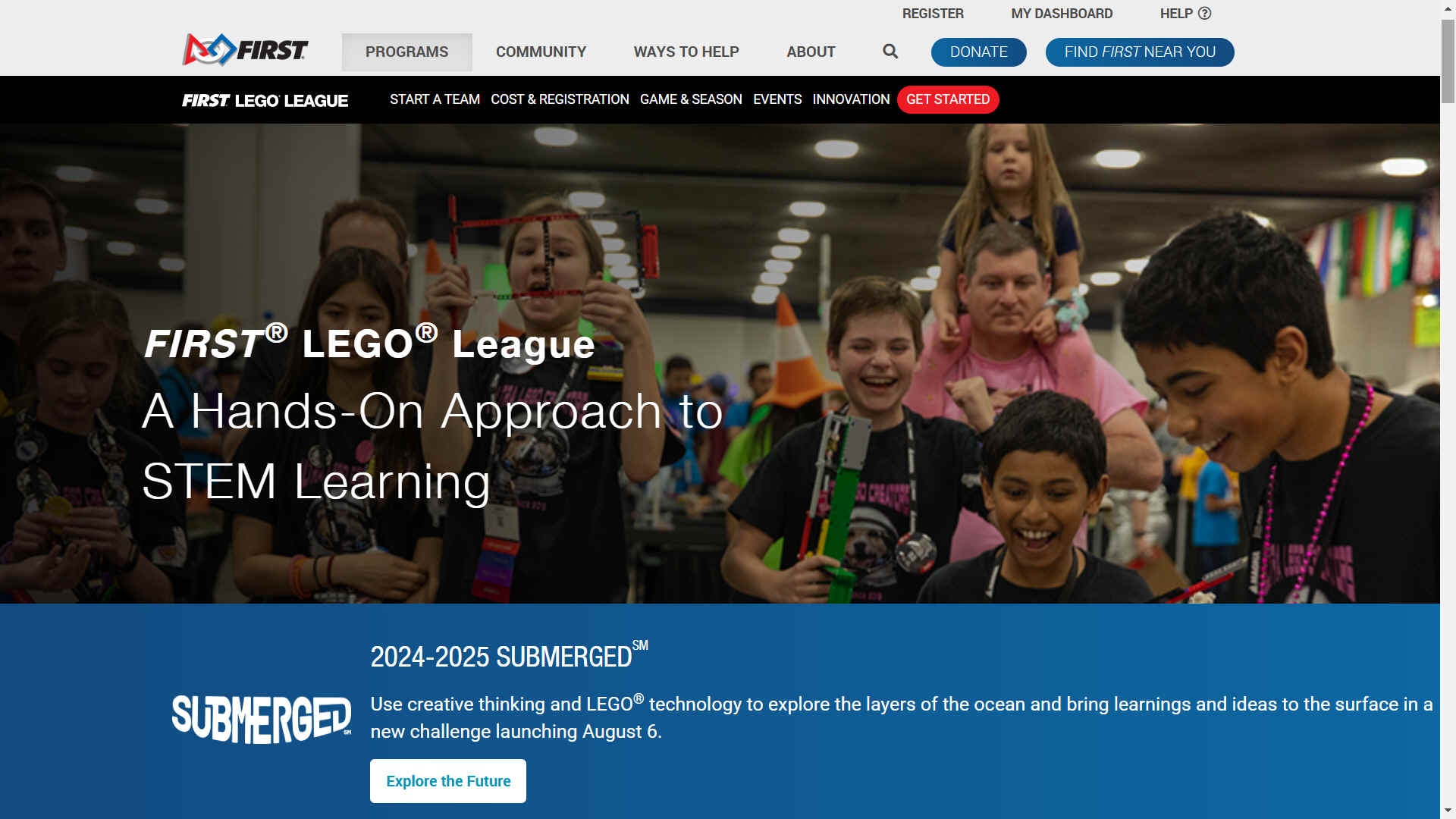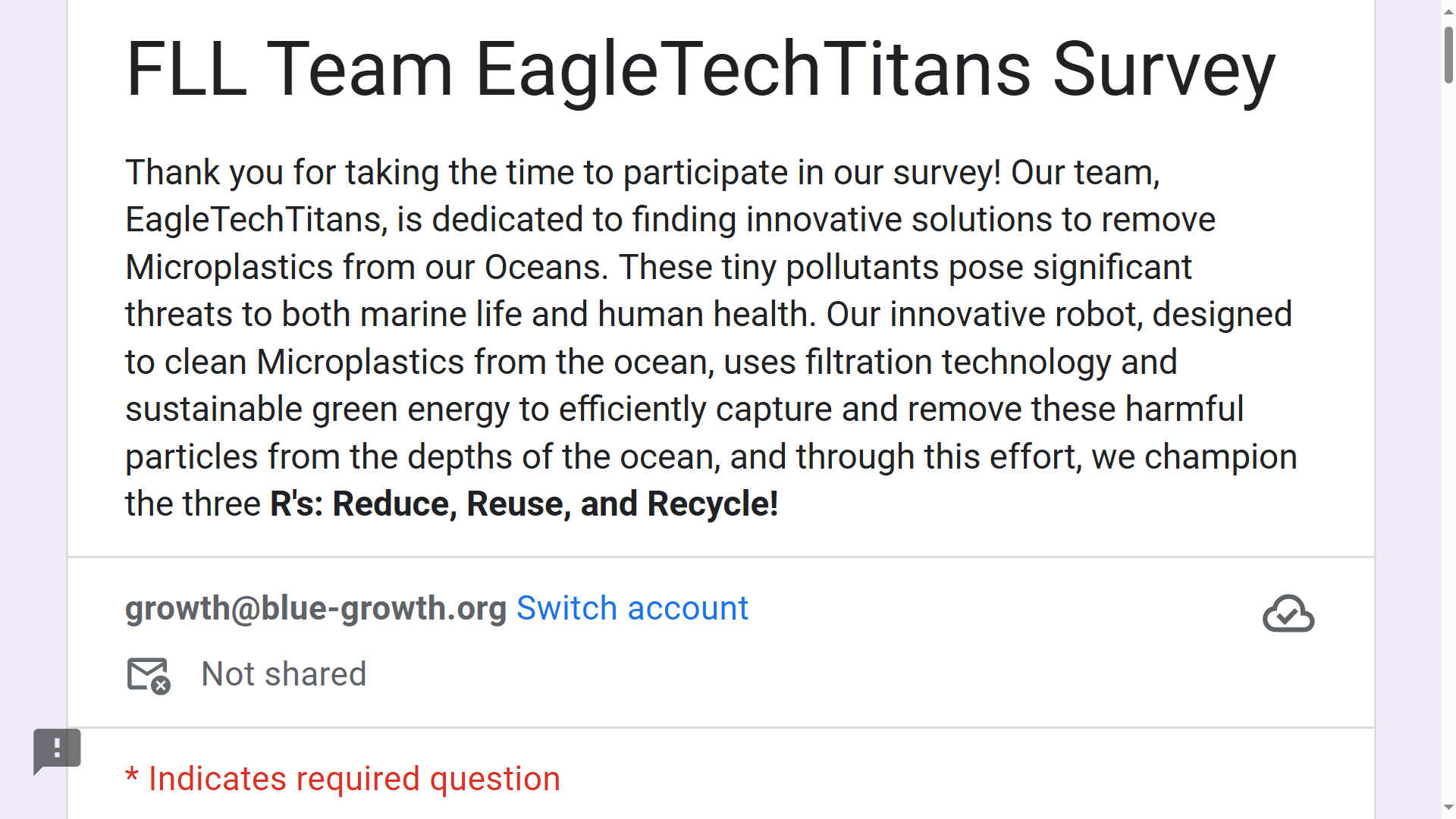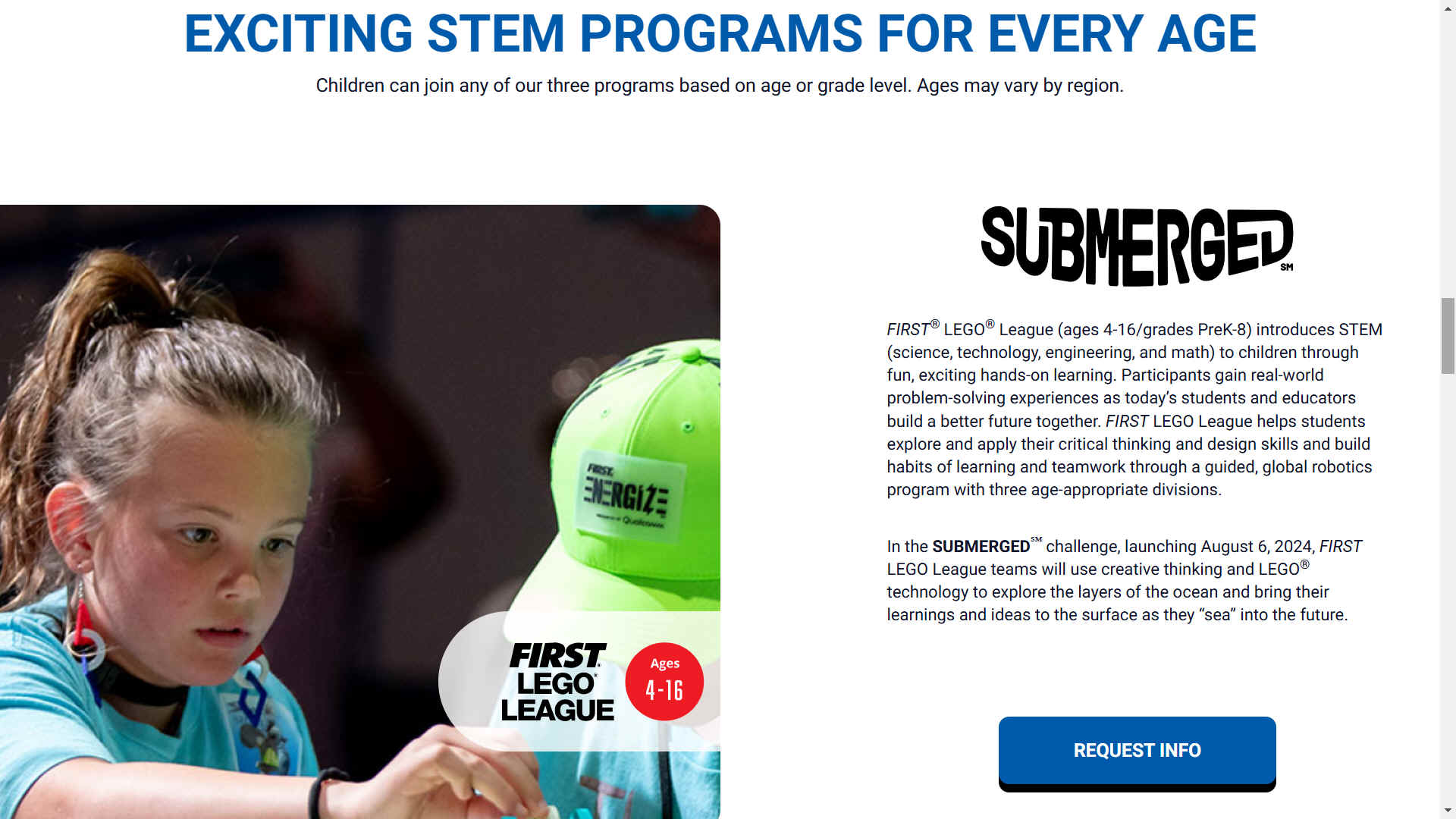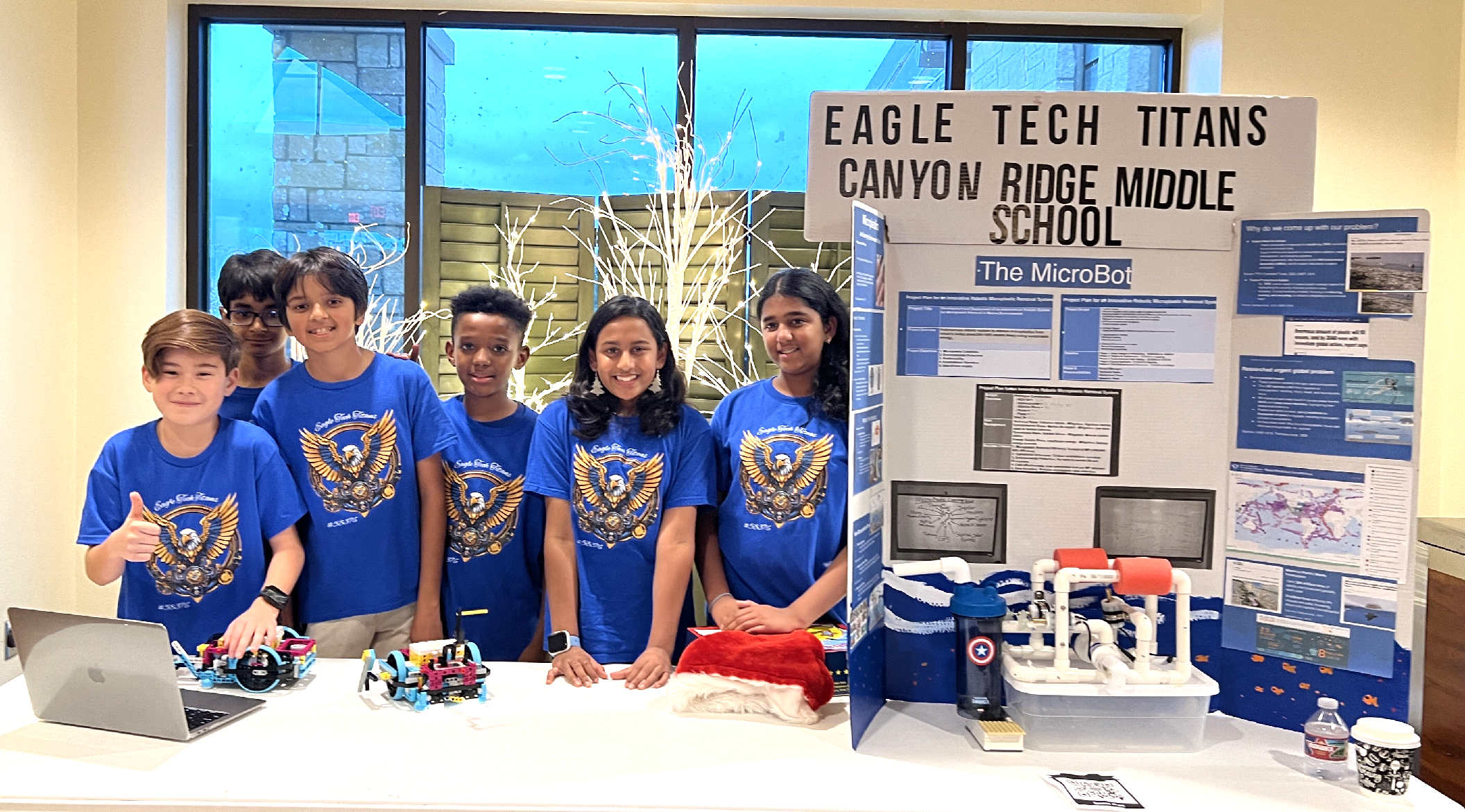|
EAGLE TECH TITANS MICROPLASTICS CLEANING SYSTEM
PLEASE USE OUR A-Z INDEX TO NAVIGATE THIS SITE OR RETURN HOME
|
|||
ENGAGING
YOUTH IN STEM EXPLORATION
- FIRST® LEGO® League introduces STEM (science, technology, engineering, and math) to children ages 4-16 (varies by region) through fun, exciting hands-on learning.
Thank you for taking the time to participate in our survey! Our team, EagleTechTitans, is dedicated to finding innovative solutions to remove Microplastics from our Oceans. These tiny pollutants pose significant threats to both marine life and human health. Our innovative robot, designed to clean Microplastics from the ocean, uses filtration technology and sustainable green energy to efficiently capture and remove these harmful particles from the depths of the ocean, and through this effort, we champion the three R's: Reduce, Reuse, and Recycle!
The
Eagle Tech Titans contacted Cleaner Ocean Foundation seeking feedback from experts in oceanography, marine biology, and robotics to evaluate the practicality and eco-friendliness of
their design. Specifically, they sought guidance on the following areas:
b) Would it be feasible to implement a closed-loop system for the robot’s materials (e.g., using recycled components) to minimize waste?
c)
Are there specific ocean zones with lower sound sensitivity where this robot could operate without significantly impacting marine ecosystems?
b)
Could you suggest strategies for optimizing green energy use in this context?
b)
If the microplastics collected can have a different end of life than a landfill, what alternative solutions would you recommend?
According to the Organization for Economic Cooperation and Development (OECD), global plastic production has now surged to 400 million metric tons annually, yet only 9% of plastic waste is effectively recycled worldwide. The rest—91%—ends up in landfills, incinerators, or natural environments, where it pollutes ecosystems, leaches toxins, and breaks down into harmful microplastics. North America, for instance, recycles just 5% of its plastic waste, while Europe leads globally at a still-low 15%. Without intervention, production is projected to rise 70% by 2040, worsening the crisis (OECD, 2022). According to UNCTAD, the volume of plastic exports grew from 218 million tons (MT) in 2005 to 344 MT in 2022. To illustrate, it would take 17.2 million trucks, each carrying 20 tons, to deliver the 2022 global plastics exports to their destination, if carried on road.
These were the initial replies from COF:
1. Sound pollution is less of an issue with electric (solar) boats. But workboats are noisier. Some noise is unavoidable, as with all motorised boats and ships. 300 more vessels out at sea is unlikely to make a significant noise impact on marine life in the round. Design with rubber/neoprene insulation in all mountings. Use satellites to target plastic hotspots, to increase efficiency, and select areas of harvesting operations with lower fauna ratios. Avoid migratory routes for cetaceans. Look at car exhaust silencer systems as a starter for ways to reduce sound levels, that and nuclear submarines, where silent running is important.
2. This is a design issue, requiring considerable experimentation. We didn’t get that far.
[We conceptualized several stages of physical filtration systems, allied to switching between hydro-cyclonic chambers to deal with smaller plastic particles, but only when safe to do so. This included using optical and other identification of the ocean and robotic controls to optimize operations. As robotic experiments were not conducted, the Foundation cannot offer any real guidance.]
3. We are presently designing/building the Elizabeth Swann hydrogen ship, in effect a green energy feasibility project. We believe the concept is sound. Time will tell as to ways forward. See our JVH2 competition. Designed to encourage transport engineers to find solutions, in very early stages of promotions.
[This Elizabeth Swann is a surface vessel, as was the SeaVax, where green energy is viable for cleaning up operations down to 3 meters and transport. COF did look at the possibility of cleaning sunken plastics in deep water trenches and the like, coming to the conclusion that, even with renewable energy, such cleaning operations would be impractical at scale. Though, that does not preclude the possibility that the technical challenges may be overcome.]
4. Recovered plastics can be almost fully recycled, if clean. Most ocean plastics are clean. Sorting is important. Again, we never got past the thinking stage on these issues, though did find plastics recycling partners, as part of funding applications.
OCEAN AWARENESS & LOBBYING
Students of robotics and engineering should not have to concern themselves with ocean politics, as may distract them from an already challenging submerged task.
FUNDING
There are many avenues to fund research, but few to fund social enterprises. That challenge comes much later, as and when promising technology offers a breakthrough.
THE ENGINEERING CHALLENGE
In the commercial world engineering is all about cost. How to make a product that works at a price to make it economically viable, or practical. In the world of experimental robotics and learning, this may not be an issue, but is sure to become one as solutions are discovered.
FOOD SECURITY
Technology that holds the potential to reduce marine pollution, is of benefit to fishermen and the blue economy. If marine plastic is a sponge for toxins. Might not harvesting that plastic help to prevent contaminating the ocean? Instead of letting it sink to the depths as a deep sea layer of all that is bad from industrial pollution. A dead zone perhaps?
It might be that one day plastic ingesting microbes evolve that are immune to toxins, to come to the rescue. That is potentially one area of research in the long term. Deep sea (relatively) mining of manganese nodules is already commercially viable.
The EagleTechTitans displaying their 'MicroBot' with informational boards about plastics in the ocean and the technological challenge. These students are tackling one of the most important live issues today. They are facing an engineering logistical challenge that so far has eluded the very best scientists all over the world. But then, when experts analyzed the humble bumble bee, they concluded it could not fly. Where there is a will, there is a way. Keep at it ETT. We are all behind you.
The approach of the Eagle Tech Titans is commendable. Always look at the history of a problem and the many proposals for solutions, while formulating your own concept.
First of all, you need to demonstrate that the technology works. It is not a good idea to extend yourself past your immediate capacity - especially financial. The SeaVax team proved the theory, but could not proceed to refine the concept to protect marine life and maximize plastic harvesting efficiency.
Pick one area of experimentation and use as much off the shelf (prior art) to help you to make progress. You don't need to reinvent the wheel.
Set a budget you can afford to lose. You will not get any of that money back, not that you'd want to. But bear in mind in later life that grants for research are not retrospective. Only start on a project that is fully funded.
Every experiment counts, adding to your knowledge.
Do not be put off by the SeaVax tale of woe. Be wary!
The fun is in the learning : )
CONTACTS
Eagle Tech Titans FLL Team eagletechtitans@gmail.com
OCEAN CLEANUP PROJECTS
* Adidas * Algalita research foundation * Aliance to end Plastic Waste * Boyan Slat's ocean booms * Fionn Ferreira's ferrofluid extraction of microplastics * LEGO Eagle Tech Titans, micro plastic robot, Texas * 4Ocean recycled plastic bracelets * Plastic Oceans Canada * Plastic Oceans Org * Seabin * SeaVax autonomous drones * Surrey University PIRATE & Triton
LINKS & REFERENCE
https://www.firstinspires.org/robotics/fll https://www.oecd.org/en/topics/plastics.html https://news.un.org/en/story/2024/12/1157646 https://news.un.org/en/story/2024/12/1157646 https://www.oecd.org/en/topics/plastics.html https://www.firstinspires.org/robotics/fll
|
|||
|
ABS - BIOMAGNIFICATION - CANCER - CARRIER BAGS - COTTON BUDS - DDT - FISHING NETS HEAVY METALS - MARINE LITTER - MICROBEADS - MICRO PLASTICS - NYLON - OCEAN GYRES - OCEAN WASTE PACKAGING - PCBS - PET - PLASTIC - PLASTICS - POLYCARBONATE - POLYSTYRENE - POLYPROPYLENE - POLYTHENE - POPS PVC - SHOES - SINGLE USE - SOUP - STRAWS - WATER
PLEASE USE OUR A-Z INDEX TO NAVIGATE THIS SITE
|
|||
|
This website is provided on a free basis as a public information service. copyright © Cleaner Oceans Foundation Ltd (COFL) (Company No: 4674774) 2024. Solar Studios, BN271RF, United Kingdom. COFL is a company without share capital.
|



